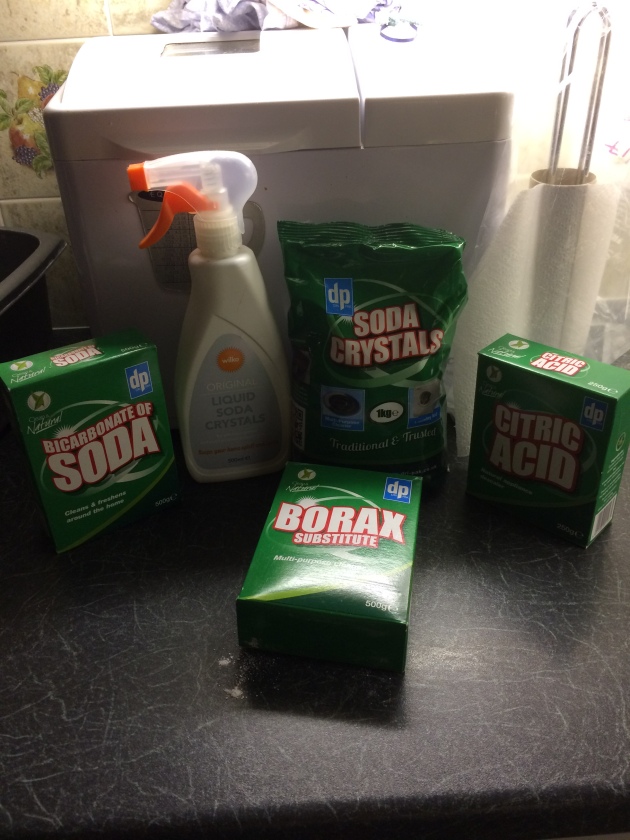
Today I’m going to share with you my Zero-Waste (almost!), eco, cheap and as plastic free as possible cleaning products! What a mouthful. Well, Zero Waste is almost never straightforward is it?
I am trying to find alternatives to all my normal, toxic cleaning products. I’ll admit I’ve had mixed success thus far, but these are my staple products, along with a bottle of Basics Vodka (around £10), a 5L bottle of white vinegar from Makro (cheapest place I can find it £2-£3) and a bottle of tea tree oil (approx 99p from my local pharmacy). I’ll list where I find them cheapest and compared to your ‘normal’ cleaning products, these tend to work out much cheaper. Dri-Pak make all the products you need and they also make them under Wilko’s own brand;
- Soda crystals (unfortunately packaged in plastic and they’re not prepared to change this. I’ve tried asking many times!) (65p a bag in Home Bargains)
- Bicarbonate of Soda (£1 per box in Savers)
- Borax Substitute (£1.79 a box in Robert Dyas)
- Citric Acid (£1.29 a box in Home Bargains, £1.50 a box in Wilko)
- Liquid Soda Crystals (£1 a bottle in Wilko)
- Liquid Soap Flakes (not pictured) £2.50 a bottle in Wilko)
- Liquid Bicarb (I can’t find this anywhere, or persuade them to stock it but it is available on places like Amazon and eBay at a price because of the weight of shipping). I’d love to try it as an alternative to Cif, as I find just sprinkling the powder about is not so convenient.
- White Vinegar (Wilko sell a spray bottle but I prefer to buy in bulk for much greater savings and decant into my own spray bottle.
If you can’t find them in the places above, then see if you have a local, independent hardware store. I have no problem locating them there, but they do cost a bit more. But then you are supporting a local business.
I will post some ‘recipes’ in some future posts, but I make my own disinfectant spray for cleaning the toilets and it works really well. We’ve been using it for the longest, over 1 year now and we’ve never gotten sick. I think it’s really effective and it’s great knowing it’s non-toxic. It’s made from white vinegar, vodka and a few drops of tea tree oil along with some cooled, boiled water. I also use it to keep cat litter trays clean. You do need a little more patience than with regular disinfectant, as you need to let it sit for 10 minutes to get to work. I just tackle another cleaning task whilst I wait.
I use soda crystals to keep my drains clear. Each week I pour a quantity into the plug hole and flush down with a kettle of boiling water. Maintenance is the key here, so do it regularly to avoid a big blockage. They are also great for softening water and I use a tablespoon in every wash which makes my laundry powder go MUCH further. You can read about this here.
I use liquid soda crystals with a metal scourer to keep my oven clean. I have posted about this before here, if you want to see the detail. I clean all mirrors and glass with white vinegar. I tried using newspaper but it made a terrible mess, so I am sticking with my microfibre cloths at the moment, though I know they are probably shedding plastic microfibres into the water system. They are AMAZING for keeping my shower free of limescale, without the need for chemicals. Read more here.
I have recently tried making my own dishwasher detergent powder from bicarbonate of soda and borax substitute. It might be plastic free, but it’s as ineffective as Sainsbury’s own brand. Sorry, but I’m going back to plastic wrapped tablets again.
I use liquid soap flakes for delicate, hand wash laundry items and I love it because it’s fragrance free. I don’t think I could afford to use it for all my washing as it’s not concentrated and I hate that it comes in plastic containers. I’d rather buy my laundry powder which comes in a cardboard box! You can also use them as a liquid hand wash.
Each week, I descale my kettle (we live in a very hard water area) with citric acid. I also do the same to the toilets once a month. I highly recommend it, it’s super-easy and the instructions are on the side of the box.
Finally, I’ve also been experimenting with cleaning the inside of the toilet bowl with bicarb and vinegar. I’ve also tried spraying in liquid soda crystals. I’m not currently convinced of their efficacy and the cost because of the amount you need to use, what with the limescale here etc seems prohibitive to me. I’m going to persevere a little longer, but I have a feeling I’m going back to a chemical cleaner in a plastic container – simply because they are around £1 a bottle, last for ages and tackle cleanliness, freshness and limescale in one hit and much more quickly than homemade remedies.
I’d recommend reading the Dri-Pak website, for lots of tips and tricks. Also check out Youtube if you need instructional videos. Do you have any tips for natural cleaning remedies that work? Do get in touch – I’d love to share the knowledge 🙂














